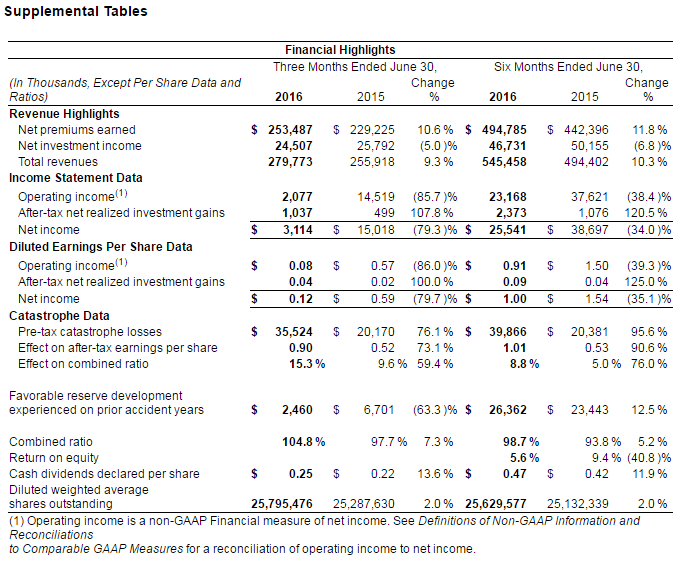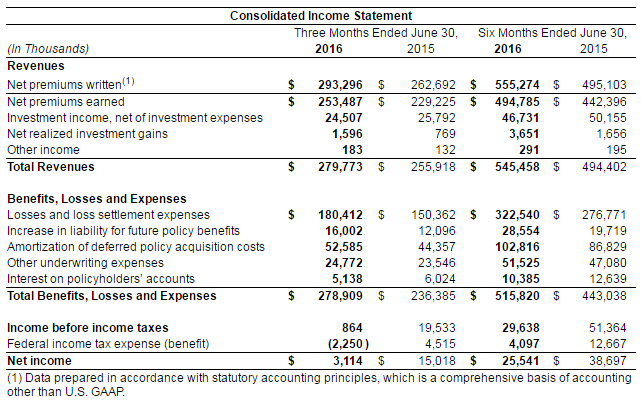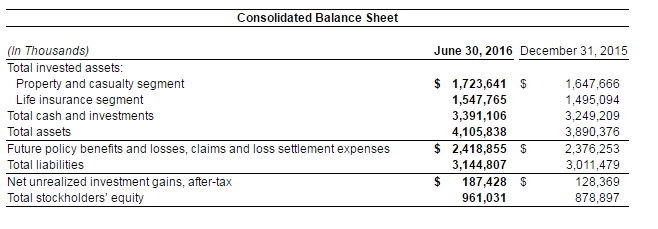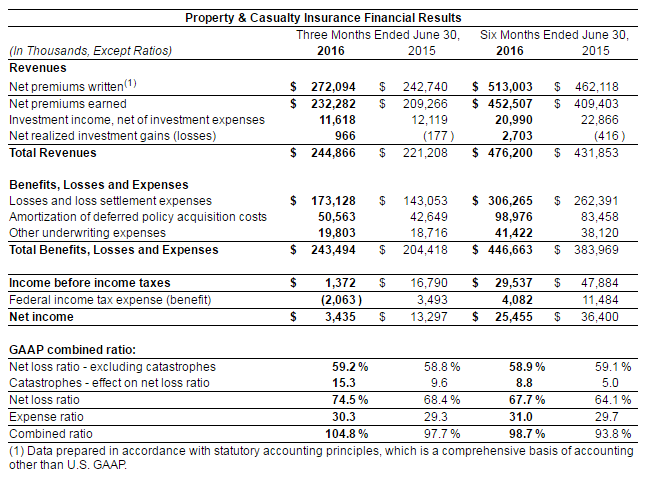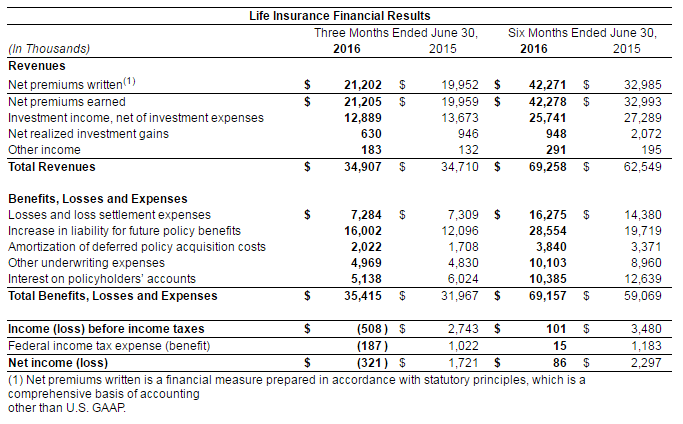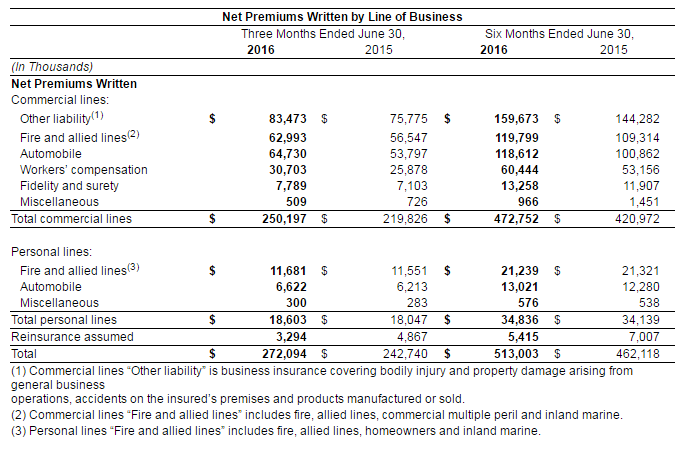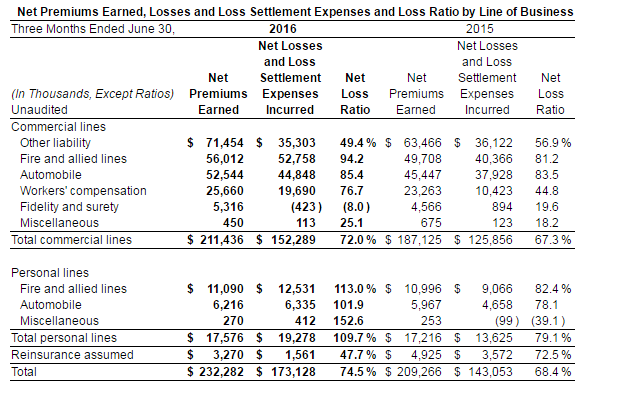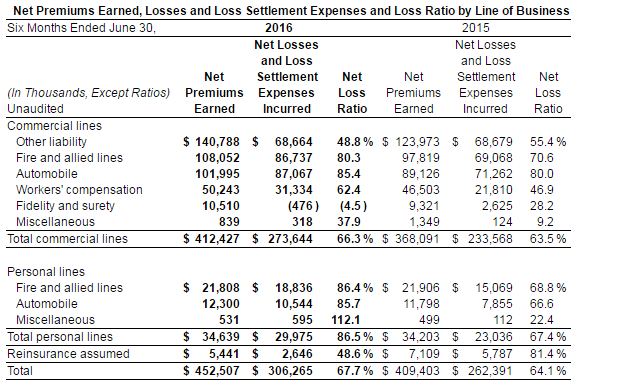
UFG News
UFG News
United Fire Group, Inc. Reports Second Quarter 2016 Results
Consolidated Financial Results - Highlights:

For the six-month period ended June 30, 2016 ("year-to-date"), consolidated net income, including net realized investment gains and losses was $25.5 million ($1.00 per diluted share), compared to $38.7 million ($1.54 per diluted share) for the same period in 2015.
The Company reported consolidated operating income(2) of $0.08 per diluted share for the second quarter, compared to consolidated operating income of $0.57 per diluted share for the same period in 2015. Year-to-date, consolidated operating income was $0.91, compared to consolidated operating income of $1.50 per diluted share for the same period in 2015.
"Our second quarter 2016 results were impacted by the increase in catastrophe losses," stated Randy Ramlo, President and Chief Executive Officer. "During second quarter 2016, we were affected by over a dozen catastrophe-designated storms dominated by hail and wind storms. A majority of these storms occurred in Texas and the Midwest."
"On a positive note, our book of business continues to grow organically," continued Ramlo. "Consolidated net premiums earned increased 10.6 percent and 11.8 percent, respectively, in the three- and six-month periods ended June 30, 2016 as compared to the same periods of 2015. Total revenues increased 9.3 percent and 10.3 percent, respectively, in the three- and six-month periods ended June 30, 2016 as compared to the same periods of 2015."
The Company recognized consolidated net realized investment gains of $1.6 million during the second quarter, compared to consolidated net realized investment gains of $0.8 million for the same period in 2015.
__________________________
(1) Per share amounts are after tax.
(2) Operating income (loss) is a commonly used non-GAAP financial measure of net income (loss) excluding realized investment gains and losses and related federal income taxes. Management evaluates this measure and ratios derived from this measure and the Company provides this information to investors because we believe it better represents the normal, ongoing performance of our business. See Definitions of Non-GAAP Information and Reconciliations to Comparable GAAP Measures for a reconciliation of operating income to net income.
(3) Return on equity is calculated by dividing annualized net income by average year-to-date equity.
Consolidated net investment income was $24.5 million for the second quarter, a decrease of 5.0 percent, as compared to net investment income of $25.8 million for the same period in 2015. Year-to-date, consolidated net investment income was $46.7 million, compared to net investment income of $50.2 million for the same period in 2015. The decrease in net investment income for the quarter was primarily driven by the change in value of our investments in limited liability partnerships as compared to the same periods in 2015 and declining interest rates. The valuation of these investments in limited liability partnerships varies from period to period due to current equity market conditions, specifically related to financial institutions.
Consolidated net unrealized investment gains, net of tax, totaled $187.4 million as of June 30, 2016, an increase of $59.1 million or 46.0 percent from December 31, 2015. The increase in net unrealized investment gains is primarily the result of a decrease in interest rates, which positively impacted the valuation of our fixed maturity security portfolio during 2016 and to a lesser extent an increase in the fair value of our equity security portfolio.
Total consolidated assets as of June 30, 2016 were $4.1 billion, which included $3.3 billion of invested assets. The Company's book value per share was $37.85, which is an increase of $2.91 per share or 8.3 percent from December 31, 2015 and is primarily attributed to net income of $25.5 million and an increase in net unrealized investment gains of $59.1 million, net of tax, during the first six-months of 2016, partially offset by shareholder dividends of $11.9 million.
The annualized return on equity was 5.6 percent for the six-months ended June 30, 2016.
P&C Segment
Net income for the property and casualty insurance segment, including net realized investment gains and losses, totaled $3.4 million ($0.13 per diluted share) for the second quarter, compared to net income of $13.3 million ($0.52 per diluted share) in the same period in 2015. Year-to-date, net income for the property and casualty insurance segment, including realized investment gains and losses, totaled $25.5 million ($1.00 per diluted share), compared to net income of $36.4 million ($1.45 per diluted share) in the same period of 2015.
Net premiums earned increased 11.0 percent to $232.3 million in the second quarter, compared to $209.3 million in the same period of 2015. Year-to-date, net premiums earned increased 10.5 percent to $452.5 million, compared to $409.4 million in the same period of 2015. The increases in both the three- and six-month periods ended June 30, 2016, were due to organic growth from new business writings and geographical expansion.
Catastrophes losses driven by hail and wind storms during the second quarter
Catastrophe losses totaled $35.5 million ($0.90 per diluted share) for the second quarter, compared to $20.2 million ($0.52 per diluted share) for the same period in 2015. Year-to-date, catastrophe losses totaled $39.9 million ($1.01 per share after tax), compared to $20.4 million ($0.53 per share) for the same period in 2015.
"Our 10-year historical average catastrophe load for the second quarter adds an average of 10.3 percentage points to the combined ratio," stated Ramlo. "However, in the second quarter of 2016 catastrophe losses added 15.3 percentage points to the combined ratio. The increase in catastrophe losses in the second quarter was driven by hail and wind storms primarily in Texas and the Midwest, impacting our commercial property, commercial auto, personal homeowners and personal auto lines of business. As a reminder, second and third quarters are typically the most significant quarters with storms and catastrophe events in geographic areas where we conduct much of our business due to spring and summer convective storms and hurricanes."
Rate increases on both commercial and personal lines in the low-single digits
"We continued to see rate increases on both commercial and personal lines renewal pricing during the second quarter," stated Ramlo. "For the commercial lines of business, the rate increases were primarily in commercial auto and commercial property."
The property and casualty insurance segment experienced $2.5 million of favorable development in our net reserves for prior accident years during the second quarter, compared to $6.7 million of favorable reserve development in the same period in 2015. Year-to-date, favorable development in our net reserves for prior accident years was $26.4 million, compared to $23.4 million in the same period in 2015. Development amounts can vary significantly from quarter-to-quarter and year-to-year depending on a number of factors, including the number of claims settled and the settlement terms. At June 30, 2016, our total reserves were within our actuarial estimates.
The GAAP combined ratio increased by 7.1 percentage points to 104.8 percent for the second quarter, compared to 97.7 percent for the same period in 2015. We attribute the majority of this increase to higher catastrophe losses in the second quarter of 2016 compared to the same period in 2015.
Expense Levels
The expense ratio for the second quarter was 30.3 percentage points, compared to 29.3 percentage points for the second quarter of 2015.
"Our expense ratio, albeit higher than prior year second quarter, was within our expectations. The expense ratio was impacted by an increase in deferred acquisition cost amortization from continued organic growth, partially offset by a decrease in post-retirement benefit expenses," stated Ramlo. "We continue to look for efficiencies to manage our expenses."
Life Segment
The life insurance segment had a net loss of $0.3 million ($0.01 per diluted share) for the second quarter, compared to net income of $1.7 million ($0.07 per diluted share) for the second quarter of 2015. Year-to-date, net income for the life insurance segment totaled $0.1 million ($0.00 per share) compared to $2.3 million ($0.09 per share).
Net premiums earned increased 6.2 percent to $21.2 million for the second quarter, compared to $20.0 million for the second quarter of 2015. Year-to-date, net premiums earned increased to $42.3 million, compared to $33.0 million for the same period in 2015. The increase was primarily due to an increase in sales of single premium whole life policies.
Net investment income decreased 5.7 percent to $12.9 million for the second quarter, compared to $13.7 million for the second quarter of 2015. Year-to-date, net investment income decreased 5.7 percent to $25.7 million, compared to $27.3 million for the same period in 2015. The decrease is primarily due to lower invested assets from declining annuity deposits and from declining interest rates.
Losses and loss settlement expenses were flat and increased $1.9 million for the three- and six-month periods ended June 30, 2016, respectively, compared to the same periods in 2015. The increase in the six-month period ended June 30, 2016 was due to an increase in death benefits paid. Fluctuations in the timing of death benefits occur from quarter-to-quarter and year-to-year.
The increase in liability for future policy benefits increased by $3.9 million and $8.8 million during the three- and six-month periods ended June 30, 2016, respectively, compared to the same periods in 2015, due to an increase in sales of single premium whole life policies.
Deferred annuity deposits decreased 2.4 percent and 26.8 percent, respectively, for the three- and six-month periods ended June 30, 2016, compared to the same period of 2015. We continue to execute our strategy to maintain profitability rather than market share, as spreads increased 42 basis points in 2016 as compared to the same period of 2015.
Net cash outflow related to our annuity business was $20.1 million for the second quarter compared to a net cash outflow of $44.2 million in the same period in 2015. We attribute this to our strategy to maintain profitability on annuity products as previously described.
Capital Management
During the second quarter, we declared and paid a $0.25 per share cash dividend to shareholders of record on June 1, 2016. We have paid a quarterly dividend every quarter since March 1968.
Under our share repurchase program, we may purchase the Company's common stock from time to time on the open market or through privately negotiated transactions. The amount and timing of any purchases will be at management's discretion and will depend upon a number of factors, including the share price, general economic and market conditions, and corporate and regulatory requirements. As of the date of this release, we are authorized by the Board of Directors to purchase an additional 1,528,886 shares of common stock under our share repurchase program, which expires in August 2016. During the second quarter, we did not repurchase any shares.
Earnings Call Access Information
An earnings call will be held at 9:00 a.m. Central Time on August 3, 2016 to allow securities analysts, shareholders and other interested parties the opportunity to hear management discuss the Company's second quarter 2016 results.
Teleconference: Dial-in information for the call is toll-free 1-844-492-3723. The event will be archived and available for digital replay through August 17, 2016. The replay access information is toll-free 1-877-344-7529; conference ID no. 10088391.
Webcast: An audio webcast of the teleconference can be accessed at the Company's investor relations page at https://ir.ufginsurance.com/event/ or http://services.choruscall.com/links/ufcs160803. The archived audio webcast will be available until August 17, 2016.
Transcript: A transcript of the teleconference will be available on the Company's website soon after the completion of the teleconference.
About United Fire Group, Inc.
Founded in 1946 as United Fire & Casualty Company, United Fire Group, Inc., through its insurance company subsidiaries, is engaged in the business of writing property and casualty insurance and life insurance and selling annuities.
Through our subsidiaries, we are licensed as a property and casualty insurer in 46 states, plus the District of Columbia, and we are represented by approximately 1,200 independent agencies. A.M. Best Company assigns a rating of “A” (Excellent) for the members of United Fire & Casualty Group.
Our subsidiary, United Life Insurance Company, is licensed in 37 states, represented by approximately 1,300 independent life agencies and rated "A-" (Excellent) by A.M. Best Company.
For more information about UFG, visit www.ufginsurance.com.
Contact: Randy Patton, Assistant Vice President of Finance and Investor Relations, 319-286-2537 or IR@unitedfiregroup.com.
Disclosure of Forward-Looking Statements
This release may contain forward-looking statements about our operations, anticipated performance and other similar matters. The Private Securities Litigation Reform Act of 1995 provides a safe harbor under the Securities Act of 1933 and the Securities Exchange Act of 1934 for forward-looking statements. The forward-looking statements are not historical facts and involve risks and uncertainties that could cause actual results to differ from those expected and/or projected. Such forward-looking statements are based on current expectations, estimates, forecasts and projections about our company, the industry in which we operate, and beliefs and assumptions made by management. Words such as "expect(s)," "anticipate(s)," "intends(s)," "plan(s)," "believe(s)" "continue(s)," "seek(s)," "estimate(s)," "goal(s)," "remain optimistic," "target(s)," "forecast(s)," "project(s)," "predict(s)," "should," "could," "may," "will," "might," "hope," "can" and other words and terms of similar meaning or expression in connection with a discussion of future operations, financial performance or financial condition, are intended to identify forward-looking statements. These statements are not guarantees of future performance and involve risks, uncertainties and assumptions that are difficult to predict. Therefore, actual outcomes and results may differ materially from what is expressed in such forward-looking statements. Information concerning factors that could cause actual outcomes and results to differ materially from those expressed in the forward-looking statements is contained in Part I, Item 1A "Risk Factors" of our Annual Report on Form 10-K for the year ended December 31, 2015, filed with the Securities and Exchange Commission ("SEC") on February 26, 2016. The risks identified in our Form 10-K are representative of the risks, uncertainties, and assumptions that could cause actual outcomes and results to differ materially from what is expressed in the forward-looking statements. Readers are cautioned not to place undue reliance on these forward-looking statements, which speak only as of the date of this release or as of the date they are made. Except as required under the federal securities laws and the rules and regulations of the SEC, we do not have any intention or obligation to update publicly any forward-looking statements, whether as a result of new information, future events, or otherwise.
Definitions of Non-GAAP Information and Reconciliations to Comparable GAAP Measures
The Company prepares its public financial statements in conformity with accounting principles generally accepted in the Unites States of America ("GAAP"). Management also uses certain non-GAAP measures to evaluate its operations and profitability. As further explained below, management believes that disclosure of certain non-GAAP financial measures enhances investor understanding of our financial performance. Non-GAAP financial measures disclosed in this report include: operating income and net written premiums. The company has also disclosed certain data according to statutory accounting rules as defined by the National Association of Insurance Commissioners' ("NAIC") Accounting Practices and Procedures Manual. The Company has provided the following definitions and reconciliations of the non-GAAP financial measures:
Operating income: Operating income is calculated by excluding net realized investment gains and losses after applicable federal and state income taxes from net income. Management believes operating income is a meaningful measure for evaluating insurance company performance. Investors and equity analysts who invest and report on the insurance industry and the Company generally focus on this metric in their analyses because it represents the results of the Company's normal, ongoing performance. The Company recognizes that operating income is not a substitute for measuring GAAP net income, but believes it is a useful supplement to GAAP information.

Net Written premium: State laws require us to calculate and report certain data according to statutory accounting rules as defined by the NAIC Accounting Practices and Procedures Manual. While not a substitute for any GAAP measure of performance, statutory data is publicly available and is frequently used by industry analysts and other recognized reporting sources to facilitate comparisons of the performance of insurance companies. Under statutory accounting rules, written premiums are the amount charged for insurance policy contracts issued and recognized on an annualized basis at the effective date of the policy. Management believes net written premiums are a meaningful measure for evaluating insurance company sales performance and geographical expansion efforts. Net written premium for an insurance company consists of direct premiums written and reinsurance assumed, less reinsurance ceded. Net earned premium is calculated on a pro rata basis over the terms of the respective policies. Unearned premium reserves are established for the portion of premium written applicable to the unexpired term of insurance policy in force. The difference between net written premium and net earned premium is the change in unearned premiums.

